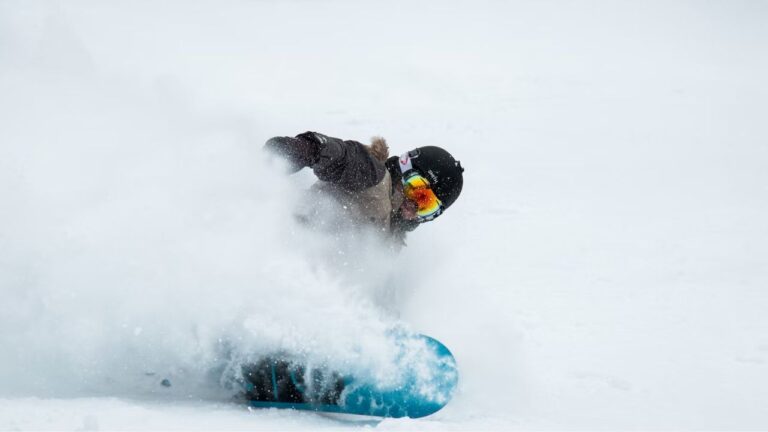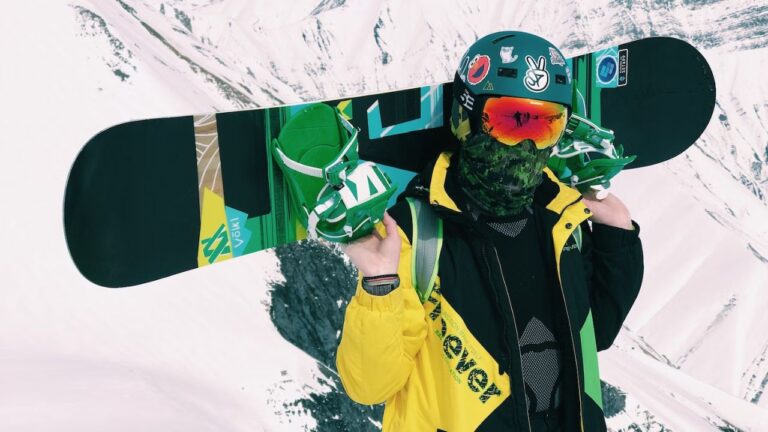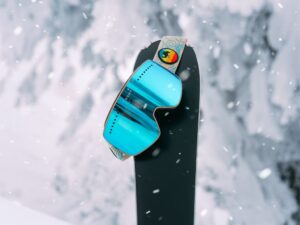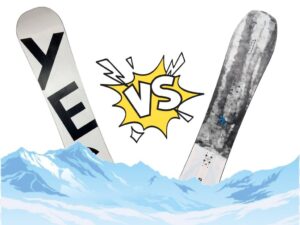The belief that stiffer boards equate to increased difficulty has been a longstanding fact in the snowboarding community. But is it really true? Or is it another myth waiting to be debunked? Let’s find out.
Snowboarding is a thrilling sport that offers a wide range of riding styles and terrains. And the stiffness of a snowboard can greatly influence your overall riding experience.
But here’s the thing: the idea that stiffer snowboards are harder to ride is a misconception.
While it’s true that stiffer boards require more technical proficiency and precise input, they also offer distinct advantages in terms of stability, control, and performance. It’s all about finding the right balance between comfort and control.
So, whether you’re a beginner or an experienced rider, understanding snowboard flex and debunking the myth of stiffer boards can be a game changer.
By the end of this article, you’ll clearly understand the truth behind snowboard stiffness and be empowered to make informed decisions when choosing the right board for your adventures.
What exactly is snowboard flex?
The flex of a snowboard refers to its ability to bend and flex under pressure.
It’s typically determined by the board’s construction and arrangement of materials. It refers to how easily a snowboard can flex longitudinally (from nose to tail) and torsionally (along its width).
The flex spectrum ranges from soft to stiff. Manufacturers often classify snowboard flex using a scale of 1 to 10, with 1 being the softest and 10 being the stiffest.

1. Soft-Flex Boards
Soft-flex boards are ideal for riders who prioritize maneuverability and playfulness. These boards excel in park and freestyle riding as they provide a forgiving ride, absorbing bumps and offering a more surfy feel.
2. Medium-Flex Boards
They are versatile and suitable for a variety of riding styles. These boards offer a blend of maneuverability and stability, making them suitable for all-mountain riding.
3. Stiff-Flex Boards
Stiff-flex boards offer enhanced stability and control at higher speeds. These boards excel in aggressive carving and provide excellent edge hold on icy or hard-packed snow.
They’re preferred by riders who prioritize speed, precision, and aggressive riding. Stiff-flex boards are often the choice of advanced riders who have developed their skills and seek high-performance snowboarding.
How does board stiffness affect your riding experience?
Contrary to popular belief, these boards offer several advantages that can enhance your snowboarding experience. Let’s focus on them today.
1. Enhanced Stability at High Speeds: The added rigidity reduces vibrations and improves control, making them ideal for riders who enjoy fast and aggressive riding.
2. Increased Edge Hold: The enhanced stiffness allows for better power transfer to the edges, providing superior grip and control when carving or making aggressive turns.
3. Enhanced Pop and Responsiveness: These boards have greater energy transfer, resulting in more powerful ollies and higher jumps.
4. Better Stability in Variable Conditions: Stiffer boards excel in variable snow conditions, such as choppy or uneven terrain.

Myth vs. Reality: Are stiffer snowboards objectively harder to ride?
Technically speaking, this belief is only partially accurate.
While it’s true that stiffer boards require more technical proficiency and precise input, they are actually relatively easy to ride once you’ve gone through the adjustment period. With practice and perseverance, you can adapt to stiffer boards and benefit from the many advantages.
The preference for snowboard stiffness is subjective and varies among riders. Some may enjoy stiffer boards’ precise control and stability, while others prefer softer boards’ forgiving nature and playfulness.
Moreover, riders can adapt to different snowboard flexes with time and experience. As riders progress in their skills and gain more confidence, they can develop the necessary technique and control to handle stiffer boards effectively.
Riders who start with softer boards as beginners can gradually transition to stiffer boards as they improve their riding abilities. Experimenting and finding the right balance that suits your riding style and goals is important.
Can a beginner ride a stiff snowboard?
As I said earlier…
Beginners can ride stiff snowboards, although it may pose initial challenges. Precise input, technique, and gradual progression are key to adapting and enjoying the stability and responsiveness they offer. Seek guidance and focus on developing control and mastering basic maneuvers.
While it’s true that beginners are often advised to start with softer or medium-flex boards, it doesn’t mean that beginners cannot ride stiffer boards. Ultimately, the choice depends on the individual’s comfort level, determination, and willingness to adapt.
If you’re a beginner interested in riding a stiffer board, there are a few things to keep in mind:
1. Proper Technique and Control: This includes mastering basic turning and stopping maneuvers, maintaining a centered stance, and effectively distributing weight.
2. Gradual Progression: Begin with a softer or medium-flex board to build confidence and develop your skills. You can transition to a stiffer board that matches your riding style as you become more comfortable and proficient.
3. Seeking Guidance: Consult with experienced riders or professionals who can offer advice and guidance based on your needs and progression.
Everyone progresses at their own pace, and what works for one person may not work for another. As a beginner, listening to your body and assessing your comfort level and skill development is crucial when riding a stiffer snowboard.

How to choose the right flex?
Selecting the appropriate flex will ensure that you have a board that matches your riding style, skill level, and terrain preferences.
1. Assessing Riding Style and Terrain
Think about the type of snowboarding you enjoy the most. Are you a freestyle enthusiast who loves hitting the park and mastering tricks?
Or do you prefer carving aggressive turns on groomed runs? Your riding style will help guide your decision on flex.
For freestyle riders, softer or medium-flex boards are generally preferred. The flexibility allows for easier maneuverability and greater playfulness, enabling you to precisely execute tricks.
If you’re more inclined toward aggressive carving and high-speed riding, stiffer boards with excellent edge hold will provide the stability and responsiveness you need.
The type of terrain you typically ride also influences the flex of your snowboard. If you enjoy exploring powder-filled backcountry or riding off-piste, a stiffer board with a setback stance and a rocker or hybrid profile is recommended.
The stiffness provides stability and control, while the rocker or hybrid profile enhances floatation and maneuverability in deep snow.
In comparison, if you predominantly ride groomed runs or encounter icy conditions, a stiffer board with a camber or hybrid profile offers superior edge hold and stability. These boards excel in carving precise turns and maintaining control on hard-packed snow.
2. Skill Level and Progression
Consider your skill level and progression as you choose the appropriate snowboard flex.
Beginners:
Starting with a more forgiving flex is advisable if you’re a beginner. Softer or medium-flex boards are often recommended for beginners as they provide a more relaxed and forgiving ride.
Softer boards provide better forgiveness when making mistakes and require less effort to initiate turns. As you progress and gain confidence, you can gradually transition to stiffer boards that offer more responsiveness and control.
Intermediate and Advanced Riders:
Snowboarders who have developed their skills can benefit from stiffer boards. These riders have the necessary technique and control to handle stiffer boards’ increased responsiveness and power transfer.
Expert QnA
Are stiffer snowboards suitable for beginners?
Stiffer snowboards are generally not recommended for beginners as they require more technical proficiency and precise input. It’s usually more beneficial for beginners to start with a softer flex board that offers forgiveness and easier maneuverability.
Can I ride park and do tricks on a stiffer snowboard?
While riding park and performing tricks on a stiffer snowboard is possible, it may be more challenging compared to a softer flex board. Stiffer boards prioritize stability and control, which may limit their playfulness and ease of executing tricks in the park.
Are stiffer snowboards faster?
Generally, the speed of a snowboard primarily depends on factors such as waxing, base structure, and rider technique. While stiffer snowboards may feel more stable at high speeds, they do not inherently make you faster.
Can a lighter rider handle a stiffer snowboard?
Technically, lighter riders may find it more challenging to control a stiffer snowboard. Lighter riders often prefer softer flex boards that provide better flex engagement and allow for easier maneuverability.
Can a heavier rider benefit from a stiffer snowboard?
Heavier riders can benefit from riding stiffer snowboards as the increased stiffness provides better stability and prevents excessive board flexing. Stiffer boards can handle the additional weight and offer improved control, especially at higher speeds.
Can I adjust the stiffness of my snowboard?
Snowboard stiffness is primarily determined by the board’s construction and materials, which cannot be adjusted. However, the feel of a snowboard can be influenced by binding placement and adjustments.
Experimenting with different binding positions can slightly affect the flex pattern and feel of the board, allowing you to fine-tune their setup to their preferences.



